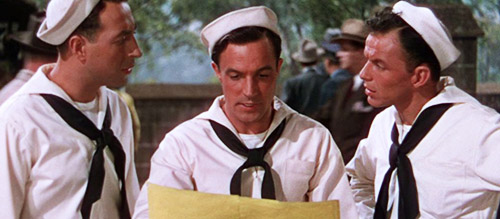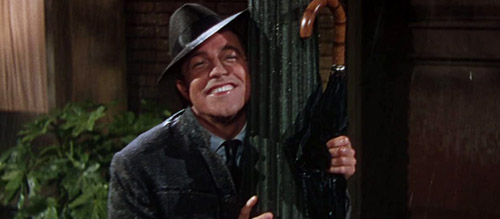Where to Start with Gene Kelly
Gene Kelly is one of cinema’s most recognisable stars and an icon of Hollywood’s Golden Era. Born in Pittsburgh in 1912, Kelly was a screen presence who stood out from the crowd at a time of mythical legends and all-time greats, his wide smile, all-American accent and incomparable ballet skills making him a ginormous box office attraction in some of the great musicals of the late 40s and early 50s.
Kelly’s legacy as a leading man is one of the joy he seemed to have in each of his performances, while the sheer magnitude of his screen choreography has arguably never been surpassed. “Imagination” is the word that is perhaps most synonymous with this great filmmaker’s work, the perfectionist behind the scenes producing, directing, choreographing and performing perfection on the screen.
So timeless are Kelly’s films, that it feels almost unimaginable to have been without him for a quarter of a century, but in looking back on this career of award winners, all-time greats and some of the most influential films ever made, we are not short on examples of this form-shaping creator’s unique talents.
In this edition of Where to Start with…, we here at The Film Magazine are looking at three such examples; the three films from Gene Kelly’s legendary career that provide the best first impression of a filmmaker whose output is simply unmissable. Whether you’re a fan of musicals or not, each of the films listed here has something unique, interesting and characteristically beautiful to offer you.
1. On the Town (1949)
Kelly and his co-director Stanley Donen were a few years away from achieving the best work of their careers when On the Town was released in 1949, but this progressive and playful musical largely about the pursuit of sex remains as watchable in 2021 as it did over 70 years ago.
In On the Town, Gene Kelly stars as the lead of three sailors (also including a youthful Frank Sinatra) looking to experience the bright lights and unique experiences that only New York City can offer. His innocent pursuit of “Miss Turnstiles” (Vera-Ellen) provides an anchor for those more interested in the great performer’s wide-eyed romantic side, but the bookended narrative of sailors departing their full-time labour jobs for 24 hours of delightful experiences (in “New York, New York”) points towards the progressive and leftist points of view of the man himself.
Here, the three sailors are just one trio of all-singing and all-dancing men looking to cram all of their life experiences into their relatively minuscule breaks between gruelling work shifts, a telling commentary on labour laws and the most disadvantaged of the working class. The three “gals” the trio find themselves coupled with are also progressive for the late 40s, each given the power to shape On the Town’s narrative: Betty Garrett’s Brunhilde quite obviously forces Alice Pearce’s Lucy out of their shared apartment so she can have sex with Sinatra’s Chip (a man she has pursued without embarrassment for the entire film to that point), while Ann Miller’s Claire bends Jules Munshin’s Ozzie over her knee to slap an unexpected but duly welcome kiss on his face after discovering he may be interested.
Beyond the representation and progressive politics, On the Town is a remarkable feat in filmmaking, a number of its scenes taking place on location in New York City itself, a tasking endeavour back when cameras were larger than people and weighed about as much as a car. Seeing a choreographed dance routine from a genius like Kelly performed in amongst the bustle of New York City never gets old, and the film’s romanticised presentation of the big apple’s towers of lights is as iconic as New York City gets on film.
Attractive, nimble, gracious and utterly watchable, Gene Kelly was in his prime when On the Town came out, his involvement behind the scenes in choreographing, directing and producing this film helping to focus its many technical achievements on what we all want the most: entertainment. After more than seven decades, On the Town remains an extraordinary film filled with passion, genius and joy; a perfect place to start with Gene Kelly’s career.
2. An American in Paris (1951)
There aren’t many films that can boast two of the greatest character introductions in history, one of the greatest fourth wall breaks of all time, and arguably the most spectacular final act ever put to celluloid in the same film, but An American in Paris certainly can.
While Gene Kelly was officially listed as choreographer and star in this 1951 musical from Meet Me in St. Louis director Vincente Minnelli, Kelly was actually responsible for directing both “I Got Rhythm” and “Embraceable You” owing to Minnelli’s obligation to direct Father’s Little Dividend, the star also taking control for An American in Paris’ astonishing 17 minute closing dance sequence; a journey of evolving colours and dance styles that has simply never been surpassed.
Playing a failing artist living out of a tiny box studio flat in Paris, France, Kelly’s Jerry Mulligan flirts with two different lovers and two different destinies in An American in Paris. Music and dance numbers are harder to come by than in a lot of Kelly’s other work (On the Town included), with more subtle routines – such as a now iconic wake-up scene in which Kelly kicks and sways his way between obstacles in his tiny apartment – connecting a relatively dialogue-heavy project that showcases the best of Kelly’s acting capabilities.
In An American in Paris, the very best of what we consider to be classic romance tropes are on offer, while the Golden Era’s iconic lavish sets and instantly recognisable colour palette are integral to the viewing experience. Cinema like this is what made the form so popular and why cinema continues to demand the label of “art”; everything seen here is world-leading dream factory stuff, a fantastical and otherworldly audio-visual sensation that we had previously thought we could only experience whilst asleep.
3. Singin’ in the Rain (1952)
It’s virtually impossible to think of great movie musicals without at least offering a passing thought to Singin’ in the Rain, such is this classic’s indelible legacy. In a career as a performer and filmmaker filled with critical and audience hits, this 1952 co-directed effort (alongside Stanley Donen) is Gene Kelly at the very height of his powers.
Constructed from the throwaway songs of other studio films released in the years prior, Singin’ in the Rain was a musical made backwards: the songs dictating the narrative as opposed to the other way around. Even so, it doesn’t fail to floor you.
Singin’ in the Rain is perhaps not as imaginative as An American in Paris, or as essential to the progression of filmmaking techniques as On the Town, nor is it necessarily as focused and form-shaping as the great works of fellow legend of dance Fred Astaire, but this Kelly-Donen offering is the very best combination of these things ever put to film, the perfect culmination of 30 years of rapid artistic and technological progression.
Every song is a hit and every dance number is tremendously detailed. Kelly himself is a vision of perfection, his routines combining with detailed camera choreography to offer cinema that does more than simply present a stage musical on screen, but undeniably enhances that experience.
Singin’ in the Rain is Gene Kelly at his best, or at least his most refined, and for that reason it is an essential launching point for exploring this great filmmaker’s legendary career. If you can watch this internationally renowned mega-hit and not fall in love with Kelly as a screen presence, then what are you doing here?
Recommended for you: [VIDEO] 30 Greatest Musical Numbers from Movie Musicals
Gene Kelly is a filmmaker whose star persona has far out-lived the man himself, this great silver screen icon remaining a vital part of our culture, whether that be directly or through his continued influence on song, dance and/or film, and this is in no small part due to his outstanding ability to create new filmmaking techniques, to create high art, and to create unrivalled joy.
If you choose to experience the work of Gene Kelly, you shan’t be disappointed. Let us know how you get on in the comments below, and be sure to follow The Film Magazine on Facebook and Twitter for more articles like this one.





Good article. I love Gene Kelly, the greatest quadruple threat in Hollywood history.